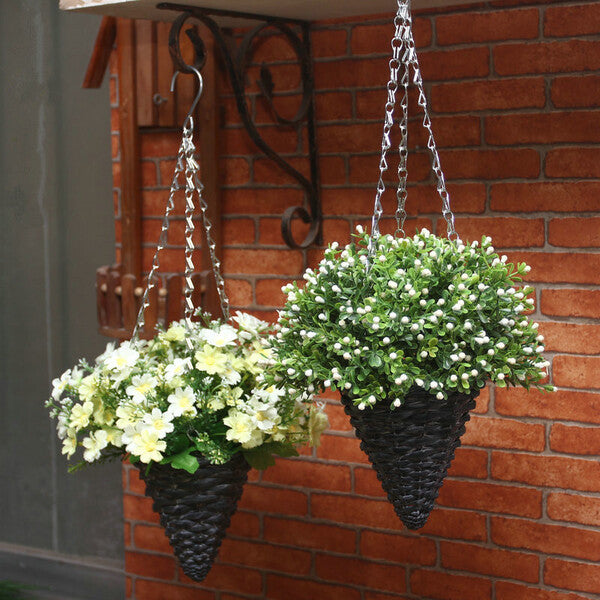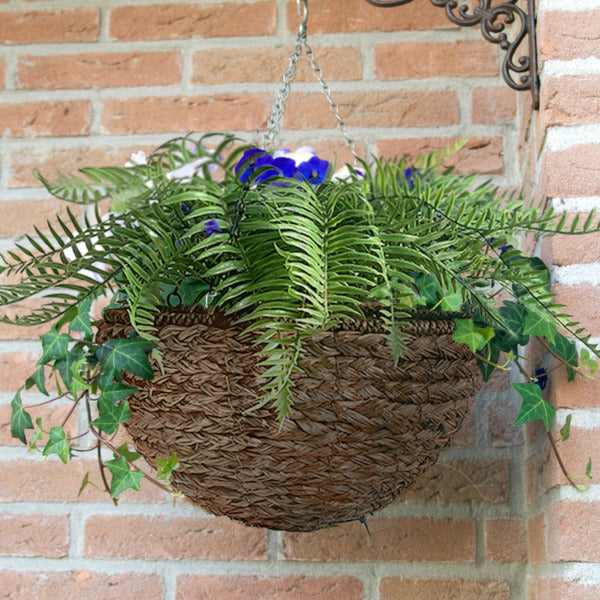Are you in love with greenery but not even close to having a green thumb?
It’s a hard predicament and one we’re very familiar with.
Okay, we’ll stop being dramatic and talk about how you can keep in touch with nature without the looming threat of your plants dying. The answer is - hanging artificial plants!
First - they won’t die. Second - they’re hung from the ceiling and don’t need specific soil conditions.
But to make it even better - you can also learn how to make a hanging basket for artificial plants yourself. The baskets are easy to make and will instantly become the focal point of the space.
And no, you don’t have to be a seasoned DIYer to enjoy making them - a step-by-step guide and some inspiration are enough to get you started.
If you’re ready to get your home decor to the next level, keep reading!
What Is a Hanging Basket?

If you’ve never heard the term hanging basket before, let’s get some details out of the way first.
A hanging basket is a decorative container usually filled with plants and flowers suspended from the ceiling or a beam. You can buy these baskets or make them yourself using materials found in your everyday life.
There are hanging baskets in various shapes, sizes, and materials, like wire, wicker, or plastic. Most people use hanging baskets to display trailing or cascading plants and create a dynamic foliage display.
And the best part is that you can use them both indoors and outdoors as a beautiful addition to any space. They’re versatile and complement many decor styles, from traditional to modern.
How to Build a Hanging Basket for Plants?

So, if you want to know how to make a hanging basket for flowers and plants, we’ve provided the steps needed to get your project going.
But before you start, have an idea in mind. What do you want your basket to look like? Do you want to include various types of faux plants or just one? Would the placement of the basket work well with the rest of the decor?
When you have an answer, it’s time to:
Step 1: Choose a Basket
In the beginning, you should select the right basket for your artificial hanging plant arrangement. Don’t rush this, it’s crucial for both functionality and aesthetics.
Before you pick a basket, make sure you have a hook installed on the ceiling or on the wall. Then, consider the size, shape, and material of the basket so that it aligns with your existing decor. The most common materials for hanging baskets include wire, wicker, coco fiber, or plastic, but there are others you can use, too.
You can also repurpose items like metal bowls and drill 3 or 4 holes an inch or two from the rim to attach hooks or ropes. This can be a sturdy base for hanging.
But if this is your first time, we recommend making a wicker basket because it’s more beginner-friendly. Whatever you choose, ensure the basket has a hook or the option for one.
Step 2: Weigh It Down
To prevent your hanging basket with faux plants from swaying in the wind a little too hard, you must add weight to the bottom. Since you’re using fake plants, you won’t need soil or other traditional planting materials. But, you’ll still need their weight.
Before adding anything to the basket, cover the inside with a layer of fabric or liner to create a barrier to ensure the weight doesn’t damage it. Then, you can use rocks or sand to weigh the basket down and help it stay in place once it’s hung.
If you’d like to have an even more realistic appearance, you can use soil to enhance the look.
Step 3: Get Floral Foam
If you’ve never used floral foam before, it’s great for creating and securing a base for your faux plants. You can get blocks of floral foam from Walmart or Dollar Tree at very affordable costs.
Break the foam into smaller chunks and place them at the bottom of the basket, underneath the weight you’ll pile on. The foam will serve as a base for your artificial plants and allow you to secure them in place.
At this stage, you should roughly know where you’d like to place your fauxliege so that you can insert the foam at the right spots beforehand.
Step 4: Pick Your Faux Plants
And now comes the fun part - selecting the faux plants for your hanging basket.
There’s no right or wrong way to do this because you can use different plants in many sizes, shapes, and colors for a more visually enticing arrangement. For example, you can combine Bougainvillea stems with Philodendron and Pearl garlands.
Alternatively, you can also choose a single plant type and pack the stems densely for a lush and full look.
Either way, the advantage of using faux plants is that you can customize the arrangement to your liking at the beginning without waiting for the plants to fill out the basket. This way, you won’t have to hope and pray the stems look nice together after a few months - you’ll have full control over it.
In any case, make sure your hanging basket plants are dense but lightweight enough to move in the wind like real greenery.
Step 5: Fluff the Fauxliege
Last but not least, take some time to fluff the fauxliege inside the basket. Once you arrange your artificial greenery, gently spread out the leaves, branches, and flowers to get a fuller and more natural look.
Don’t skip this step - it’s important to ensure your hanging basket looks lifelike. Pay attention to the spacing and the arrangement of your fake plants so that they’re evenly distributed and cover the foam and liners.
Fluffing the fauxliege will also help hide any gaps in the arrangement, which will give it a more polished appearance. Step back and take a look at your hanging basket from different angles to make the final adjustments before hanging it up.
Conclusion
In a nutshell, creating a hanging basket for faux plants is a creative way to add greenery to your space without maintaining real plants.
By following our guide and using your imagination, you can design a lifelike hanging basket that adds to your home decor. And if you need some help, contact our team - we’d love to help.

